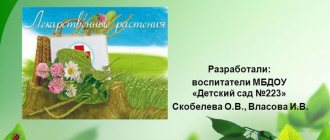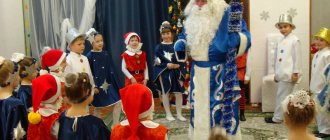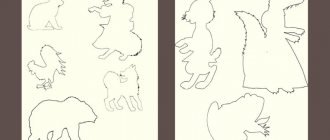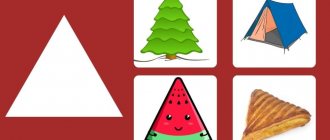Preparatory group
We offer games to consolidate and generalize knowledge about flora, expand horizons, and develop cognitive activity in preschoolers preparing for school.
Make a plant from parts
The game requires pictures divided into parts, each part representing a specific plant organ: stem, root, leaves, flowers. The game task is to create a plant from parts of the picture. It is important that the depicted representatives of the flora belong to different categories: trees, shrubs, herbs, vegetables, flowers.
Didactic game “Groups of plants”
The teacher lays out 4 pictures in front of the players, depicting plants of certain groups. The game task is to identify the extra image.
Here are the categories:
- shade-loving plants - lily of the valley, sunflower, fern, ivy;
- wild - nettle, plantain, burdock, strawberry;
- blooming - juniper, aster, lilac, flax;
- medicinal - chamomile, hawthorn, sedge, coltsfoot;
- poisonous - henbane, clover, crow's eye, castor bean;
- conifers - spruce, pine, cypress, hornbeam.
Vegetable shop
Before the game starts, the teacher tells the children that agricultural crops are taken to vegetable warehouses for storage and to enterprises for processing and preservation. Fruits and vegetables that are stored fresh must be periodically sorted for spoilage. And those fruits that are immediately processed cannot be stored for a long time and quickly rot.
Children are divided into two groups: the first play farmers bringing the harvest, the second play specialists in receiving goods. To play the game you need to make images of different vegetables, berries, fruits, and also put two tables: one will be a vegetable storage, the second will be a processing plant. Each farmer player takes a picture, approaches the goods distributor with it, and he determines where the products will go: to storage or for processing.
Forester
A game played in the forest makes familiarization with plants more effective. The teacher, playing the role of a forester, goes with the children to the forest. This could be a forest belt, a city park. The forester lays out a convenient route for the children, but does not directly tell them where to turn, but describes a tree or bush, followed by a turn. Based on the description of the foliage, the color of the bark, the splendor of the crown and other parameters, attentive preschoolers must guess where to move.
Junior group
We offer simple and exciting games that younger preschoolers can handle.
What's in the bag?
The game teaches preschoolers to recognize and describe objects by tactile perception. The lesson requires fruits and vegetables familiar to kindergarteners in the younger group: tomato, cucumber, apple, onion, carrot, radish, pear and others. The teacher places the fruits in an opaque bag. Then he asks the pupils to take turns feeling for one of the objects in the bag, but not to take it out right away, but to try to describe it and give it a name.
Choose the right one
For the game you need images of different types of plants, their parts, fruits. The teacher lays them out on the table. Then he names a property or an external sign, and the students choose pictures with plants that correspond to this definition. For example, having heard the sign “orange”, children choose the pictures “orange”, “carrot”, “pumpkin”.
Where does it grow?
The game clarifies the idea of where plants grow. Beforehand, the teacher reminds the students that there are garden, meadow, garden, field, and forest plants. Children form a circle, and the teacher stands in its center. He throws the ball to each player in turn, names the plant, and the child must say where it grows: in the garden, vegetable garden, field, forest or meadow.
Find a plant
The game reinforces the idea of what different representatives of the flora look like. For the lesson you need cards depicting plants: several pictures of each type. The teacher lays out the cards on the playground, then names a specific plant species, for example, dandelion. The players' task is to find all the dandelion images among the pictures.
Find out by description
The game expands your understanding of the external features of different types of flora, teaches you to describe natural objects, and highlight their key features. For the lesson, we need images of plants known to younger preschoolers. The teacher lays out the pictures in front of the players, then gives a clear and detailed description of one of the presented types. Based on this description, players must guess what plant they are talking about.
Find the leaf
The game is played in the fall during a walk in the fresh air, promotes general physical development, improves auditory perception, and teaches you to identify objects based on similar characteristics.
The teacher picks up a fallen leaf from a certain tree from the ground, shows it to the students, and asks them to find the same one. Children perform a similar task for each type of tree: birch, maple, ash, aspen, oak, rowan and others available in the kindergarten yard. Then the teacher gives each child a leaf of a certain type and says: “The wind blew and carried maple leaves.” Children with a maple leaf in their hand begin to dance, spin, and run. The rest are standing still. The teacher gives a similar command for holders of other types of leaves.
Planting a tree
The game develops visual perception and orientation on a plane, improves fine motor skills. For it you need to prepare counting sticks, different geometric shapes cut out of thick paper, as well as natural material: seeds, cones, dried leaves, petals. Having received the playing material, children assemble different types of trees from it on a plane.








